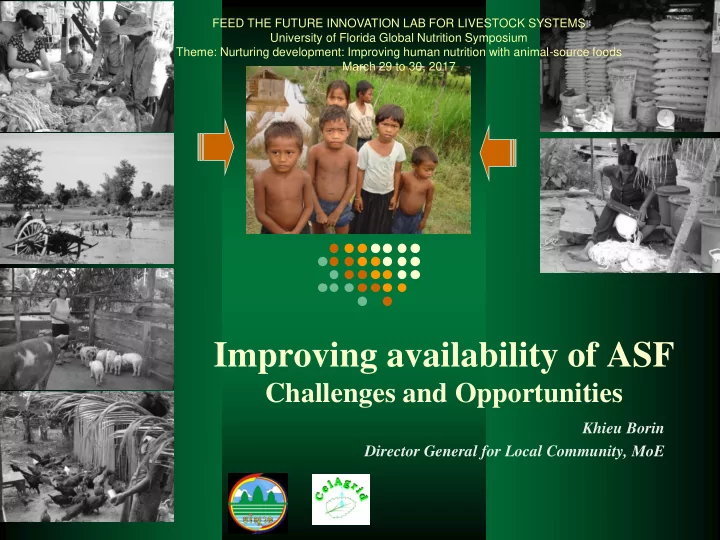

FEED THE FUTURE INNOVATION LAB FOR LIVESTOCK SYSTEMS University of Florida Global Nutrition Symposium Theme: Nurturing development: Improving human nutrition with animal-source foods March 29 to 30, 2017 Improving availability of ASF Challenges and Opportunities Khieu Borin Director General for Local Community, MoE
CONTENT o Availability and accessibility to ASF o Composition of livestock farms o Structure and conditions of livestock producers o Constraints and Opportunities in livestock production o Taking home messages
Consumers/farmers SUSTAINABILITY AVAILABILITY ACCESSIBILITY AFFORDABILITY
How can ASF improve? Technology • Feed • Breed Producers’ Demand in • the market Capital Disease control interest • Market Profitable • Extension Processing Policy support Culture/tradition
90% keep 12.7±0.74 (5-23 heads) chickens, 67% keep 2.37±0.24 (1-5 heads) cattle, 46% keep 1.41±0.16 (1-5 heads) pigs, 24% kept 6.41±2.03 (1-40 heads) ducks, and 15% keep 0.50±0.06 (1-3 heads) buffalos.
Structure of Livestock producers - Subsistent farmers - Self-sufficient farmers - Large farms
Subsistent farmers Produce for own consumption and surplus to local market low input-output as way to mitigate risk (diversification) and use local available resources. They are declining – exit or pass to self- sufficient. Change to medium or large scale New alternative incomes – work at factories, construction
Self-sufficient farmers Produce for market – contract farming Require updated technologies Credit for the expansion of their business. Largely dependent on purchased inputs Do other farm activities but more focus on unique market commodity
Large farm Sound higher bio-security practice Geographic concentration of waste technologies available to reduce environmental impact expensive to return nutrients back to the soil Contract farming or/and own in-out system
These have been almost always identified as the constraints of farmers however no systematic solutions provided? Benefi nefit t from livesto tock ck producti tion on Poor access to market and information Limited access to financial capital, agri- Limited access to quality vet services and insurance and risk reduction tools extension limited capacity to solve technical barriers
Diseases and solutions Descriptions SMF LF Vaccination, % -Salmonella 16.2 30 -Pasteurella 35.1 30 -CSF 94.5 90 -FMD 56.8 40 Aujeszky 27 30 -PRRS 73 90 Disease outbreaks, % 91.4 60 -Salmonella 26.5 - -Pasteurella 20.6 - -CSF 23.5 33.3 -FMD 11.8 - Aujeszky 8.8 33.3 -PRRS 55.9 83.3 Treatment, % 100 100 -VAHWs 35.3 - -Private vet 2.9 - -Treat by themselves 70.6 57.1 -Vet from contract farming - 71.4
Rice straw 55% is removed for animal feed 45% is left in the field. incorporate into the soil Burning Rice straw urea treatment Rice straw plus supplements
Mean values of daily weight gain 450 Mean value of daily weight gain, g 400 350 300 250 200 150 100 50 0 FCL WS WSFCL 13
Growth rates of goats 14
Mean values of daily weight gain 500 450 400 Daily weight gain, g 350 300 250 200 150 100 50 0 0 0.25 0.5 0.75 1 Level of sun dried cassava foliage, % live weight, DM basis 15
Performance of yellow cattle fed cassava pulp Composition kg/day Cassava pulp 13 Urea 0.078 0.9 kg DWG/day Brewers grains 4.46 Rice straw 1.44 Minerals 0.039 Total DM 5.3 Day 90 Day 39 Day 1
Crickets farming %Moiste %Crude %Crude %Crude N0 Name %Dry matter r Protein Ash fiber 1 Whole cricket meal 94.8 5.23 65.2 4.06 11.8 2 Leg cricket meal 96.8 3.21 67.5 5.24 13.2
Technologies and adoption Devendra and Leng 2011 reviewed 12 projects mostly from 1990s • 92% consider successful but “SCALING UP” is the matter. – Technologies are available but they are not beyond project lifetime. Why could these introduced technologies be wider adopted?
Messages to take home Does cash income and/or nutrition drive ASF from smallholders point of view? What are key starting points when smallholder farmers are the target? What should be the effective and efficient ways to promote livestock production? How best can knowledge generated be shared and used by farmers?
Thanks
Recommend
More recommend